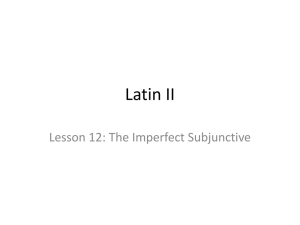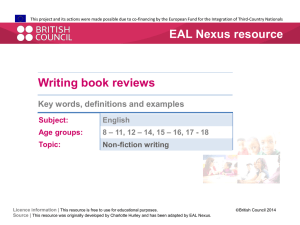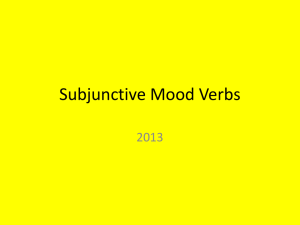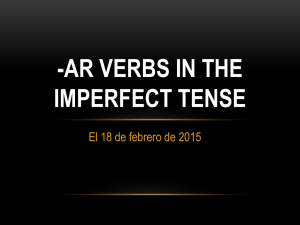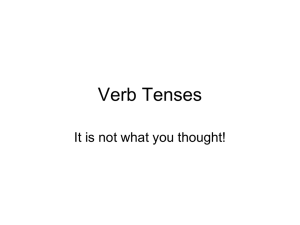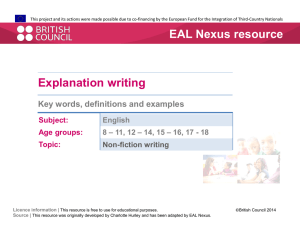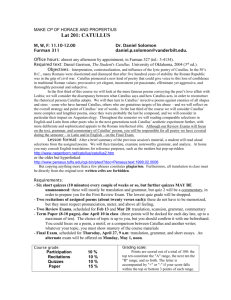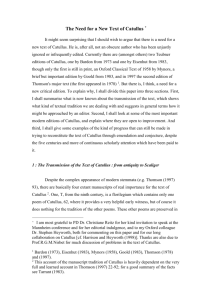3.1 Sequence of Tenses
advertisement
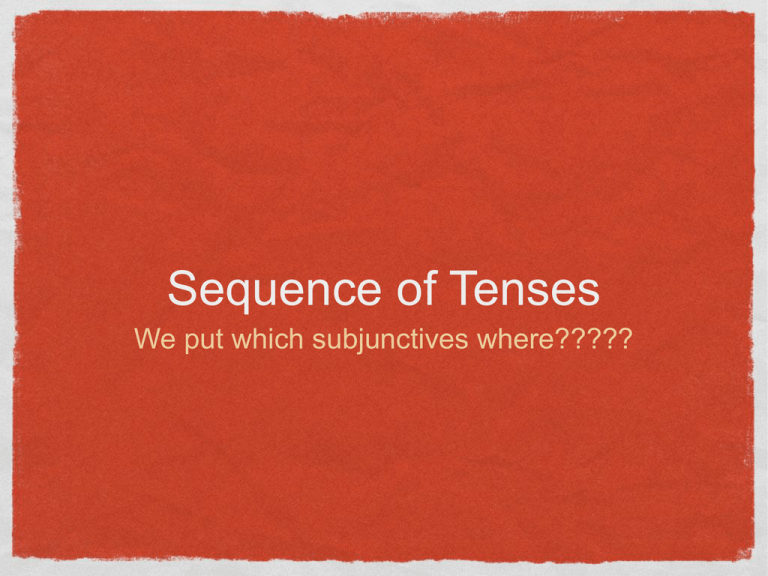
Sequence of Tenses We put which subjunctives where????? Four tenses. Why? The most important thing to remember is that, for subjunctive verbs, “tense” is a much more wobbly concept than for indicative verbs. Subjunctive verbs in subordinate clauses (which is most of them) don’t have an ABSOLUTE point in time like indicative verbs. They have RELATIVE TENSE. What is relative tense? Not “relative” like “cousin”; “relative” as in “relative to something else, not absolute”. You can compare the way the tenses of participles work. Remember that present participles take place at the same time as the main verb, and perfect participles took place before it? Uhh, so why four? That. . .is a very good question. Participles get along just fine with only two relative tenses (since the future participle is so rarely used as a pure participle). This issue of four relative tenses is the heart of Latin sequence of tenses, and, I’m afraid, it is a bit of a complication without much rational justification. OWN IT anyway! The rules!!!! The rules for when to use which tense are, in short: If your main verb is present (or future), you are only allowed to use PRESENT or PERFECT subjunctive. If your main verb is past, you are only allowed to use IMPERFECT or PLUPERFECT subjunctive. And how they work Once you have these pairings down, then each pair works just like the two relative tenses from participles: Present subjunctive is simultaneous with the main verb, perfect subjunctive is before it. Imperfect subjunctive is simultaneous with the main verb, pluperfect subjunctive is before it. Primary Sequence The two kinds of main verbs are called primary sequence and secondary sequence. For the majority of situations, primary sequence just means “present or future tense”. secondary sequence It stands to reason, then, that secondary sequence is largely a fancy way of saying “past tense”, taking in all the past tenses Latin is capable of. So, after all this time, “past tense” is STILL not a valid answer for any Latin grammar question! We say “secondary sequence”. Sorry. :( Still, it can be a helpful mnemonic that the pair of subjunctives that both have “past”-sounding names (imperfect and pluperfect) belong in secondary. Examples: Primary Consider these sentence pairs: cum Catullus carmina scribat, puella alteros viros amat. (When Catullus writes poems, his girlfriend likes other guys.) cum Catullus carmina scripserit, puella alteros viros amat. (When Catullus has already written poems, his girlfriend likes other guys.) Examples: Secondary cum Catullus carmina scriberet, puella alteros viros amabat. (While Catullus was writing poems, his girlfriend liked other guys.) cum Catullus carmina scripsisset, puella alteros viros amabat. (When Catullus had written his poems, his girlfriend liked [started liking] other guys.) NB: Though I wrote both these sentences with imperfect main verbs because it was more natural with the vocabulary, they would still be secondary sequence with perfect or pluperfect main verbs. you can’t write that!! Examples like this, however, are ungrammatical: cum Catullus carmina scripsisset, puella alteros viros amat. cum Catullus carmina scribat, puella alteros viros amaverat. Look at the tenses and figure out why! Honors notes In case you are wondering why there were so many “most of the times” in there, here are a few wrinkles that do occur in literary Latin. This may not be relevant if you’re not planning on AP Latin. I avoided writing example sentences with perfect tense main verbs for a reason. Most of the time, perfect tense verbs are considered primary sequence. However, if the author intends the “has done” sense, not the “did” sense, of the perfect tense to be the point, then sometimes they can be primary sequence. This is not as illogical as it sounds: if you think about it, a “has done” verb is really talking about the present consequences of a past action. There are also rare cases when an author uses a bizarre tense of the subjunctive to get across a special point, such as emphasizing that something is over and done. This happens most in historical writing and hopefully will not even be on the AP syllabus. Consult a Latin grammar if you’re really curious. Logical implications If you think about your types of subjunctive clauses, you may realize that not all of them actually need both of their allowable tenses. How would a tense earlier than the main verb make any sense in a purpose or result clause???? Wait a sec. . . Now that you’ve got purpose and result clauses on the brain, you may be thinking--aren’t those subjunctive actions arguably in the FUTURE relative to the main verb? This is a valid point. A quick way to answer is that the Romans saw the subjunctive and the future tense as very similar to each other. This also helps explain why there is no future or future perfect subjunctive! And another sec. . . • • • You might also be wondering--why doesn’t this have any bearing on indirect statements? You don’t have to use two totally different systems of tenses of the infinitive in those!!!! Well. . .you’re right, you don’t. The way sequence of tenses works in accusative-and-infinitive is arguably a lot more logical. You just have three tenses and they all work relative to the main verb. Unfortunately, languages aren’t designed by committee. So sometimes they aren’t totally internally consistent. :/
